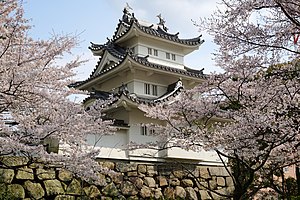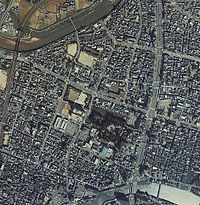Tsu Castle
This article includes a list of general references, but it lacks sufficient corresponding inline citations. (November 2018) |
| Tsu Castle | |
|---|---|
津城 | |
| Tsu, Mie Prefecture, Japan | |
 Reconstructed Yagura of Tsu Castle | |
 Tsu Castle from the air | |
| Coordinates | 34°43′3.96″N 136°30′27.57″E / 34.7177667°N 136.5076583°E |
| Type | flatland-style Japanese castle |
| Site information | |
| Condition | Reconstructed 1958 |
| Site history | |
| Built | 1558, major reconstruction in 1608 |
| Built by | Hosono Fujiatsu Tōdō Takatora |
| In use | Sengoku period-1889 |
Tsu Castle (津城, Tsu-jō) was a
Overview
During the Sengoku period, in 1558, Hosono Fujiatsu built a castle at the conjunction of the Ano and Iwata rivers, using the rivers as natural moats. The port of Anotsu had been an important port for the coastal trade along the eastern coast of Japan; however, after its destruction by an earthquake at the end of the 15th century, it was gradually eclipsed by the ports of Kuwana and Matsusaka instead.

However, during the Battle of Sekigahara in 1600, the Tomita clan sided with the eastern forces under Tokugawa Ieyasu and Tsu Castle was attacked by the western armies under Mōri Terumoto and Chōsokabe Morichika. Although the 1300 defenders put up a stiff defense, the 30,000 attackers largely burned the castle down around them. Tomita Nobutaka and his wife, Yuki no Kata, successfully defended the castle. The Tomita were rewarded for their loyalty by the Tokugawa shogunate and were given an increase in kokudaka and rebuilt parts of the castle by the time they were transferred to Uwajima Domain in Iyo Province in 1608.
The Tomita were replaced by the Tōdō clan, who ruled as
With the start of the
Some of the original stone walls have survived. One corner yagura was reconstructed in 1958. However, it is not a historically accurate reconstruction, and contains various features copied from other structures to make it more visually appealing. The gate to the Japanese garden now located within the Inner Bailey is a survival from the Edo period han school of the domain.
Tsu Castle was listed as one of the
The castle is located a 20-minute walk from
Gallery
-
Moats
-
Gate from the former Han school
-
Japanese gardens in the former inner bailey
Literature
- De Lange, William (2021). An Encyclopedia of Japanese Castles. Groningen: Toyo Press. pp. 600 pages. ISBN 978-9492722300.
- Schmorleitz, Morton S. (1974). Castles in Japan. Tokyo: Charles E. Tuttle Co. pp. 144–145. ISBN 0-8048-1102-4.
- Motoo, Hinago (1986). Japanese Castles. Tokyo: Kodansha. p. 200 pages. ISBN 0-87011-766-1.
- Mitchelhill, Jennifer (2004). Castles of the Samurai: Power and Beauty. Tokyo: Kodansha. p. 112 pages. ISBN 4-7700-2954-3.
- Turnbull, Stephen (2003). Japanese Castles 1540–1640. Osprey Publishing. p. 64 pages. ISBN 1-84176-429-9.
References
- ^ "津城跡" (in Japanese). Mie Prefecture. Retrieved August 20, 2020.
- ^ "続日本100名城" (in Japanese). 日本城郭協会. Retrieved 25 July 2019.
External links
![]() Media related to Tsu Castle at Wikimedia Commons
Media related to Tsu Castle at Wikimedia Commons
- Tsu Castle Jcastle Profile
- Japanese Castle Explorer
- Mie Prefecture Tourist Information(in Japanese)
- Tsu City tourist information(in Japanese)






